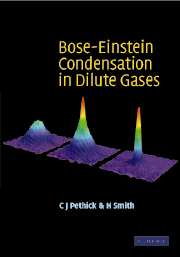Book contents
- Frontmatter
- Contents
- Preface
- 1 Introduction
- 2 The non-interacting Bose gas
- 3 Atomic properties
- 4 Trapping and cooling of atoms
- 5 Interactions between atoms
- 6 Theory of the condensed state
- 7 Dynamics of the condensate
- 8 Microscopic theory of the Bose gas
- 9 Rotating condensates
- 10 Superfluidity
- 11 Trapped clouds at non-zero temperature
- 12 Mixtures and spinor condensates
- 13 Interference and correlations
- 14 Fermions
- Appendix. Fundamental constants and conversion factors
- Index
2 - The non-interacting Bose gas
Published online by Cambridge University Press: 06 July 2010
- Frontmatter
- Contents
- Preface
- 1 Introduction
- 2 The non-interacting Bose gas
- 3 Atomic properties
- 4 Trapping and cooling of atoms
- 5 Interactions between atoms
- 6 Theory of the condensed state
- 7 Dynamics of the condensate
- 8 Microscopic theory of the Bose gas
- 9 Rotating condensates
- 10 Superfluidity
- 11 Trapped clouds at non-zero temperature
- 12 Mixtures and spinor condensates
- 13 Interference and correlations
- 14 Fermions
- Appendix. Fundamental constants and conversion factors
- Index
Summary
The topic of Bose–Einstein condensation in a uniform, non-interacting gas of bosons is treated in most textbooks on statistical mechanics. In the present chapter we discuss the properties of a non-interacting Bose gas in a trap. We shall calculate equilibrium properties of systems in a semi-classical approximation, in which the energy spectrum is treated as a continuum. For this approach to be valid the temperature must be large compared with Δ∈/k, where Δ∈ denotes the separation between neighbouring energy levels. As is well known, at temperatures below the Bose–Einstein condensation temperature, the lowest energy state is not properly accounted for if one simply replaces sums by integrals, and it must be included explicitly.
The statistical distribution function is discussed in Sec. 2.1, as is the single-particle density of states, which is a key ingredient in the calculations of thermo dynamic properties. Calculations of the transition temperature and the fraction of particles in the condensate are described in Sec. 2.2. In Sec. 2.3 the semi-classical distribution function is introduced, and from this we determine the density profile and the velocity distribution of particles. Thermodynamic properties of Bose gases are calculated as functions of the temperature in Sec. 2.4. The final two sections are devoted to effects not captured by the simplest version of the semi-classical approximation: corrections to the transition temperature due to a finite particle number (Sec. 2.5), and thermodynamic properties of gases in lower dimensions (Sec. 2.6).
- Type
- Chapter
- Information
- Bose–Einstein Condensation in Dilute Gases , pp. 16 - 39Publisher: Cambridge University PressPrint publication year: 2001



